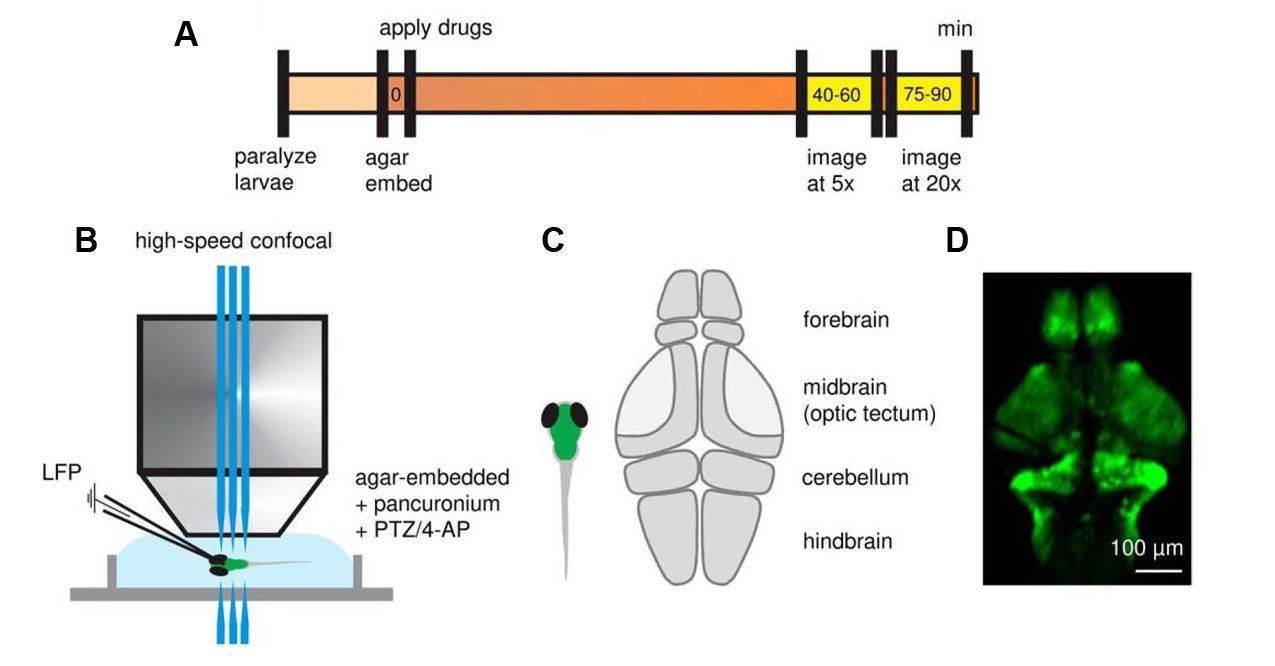Resolving Seizure Networks Using High-speed Confocal Imaging and Larval Zebrafish
Liu & Baraban investigated spatiotemporal patterns of seizure-like activity in the brain of zebrafish (Danio rerio) larvae by combining high-speed imaging of calcium indicator fluorescence with electrophysiological recording of local field potentials (LFPs). Whereas mammalian studies of epilepsy are sometimes restricted to electrophysiological recordings of in vitro slice preparations or focal brain regions in vivo, the small brain size of zebrafish permits a broad view of all brain regions affected by seizures. This brain-wide view is important as seizures involve highly synchronous activity across macro-neuronal networks. In their eNeuro publication, Liu & Baraban demonstrate distinct patterns in calcium signaling following drug-induced epileptiform activity or during a non-seizure hyperexcitable state in the brain of zebrafish larvae. These findings have implications for the understanding of how seizure activity propagates from sites of seizure initiation to other brain regions.
As a model organism, zebrafish, including its larval stages, exhibit several characteristics that are advantageous for this type of investigation. The zebrafish nervous system is simple, well-characterized, and displays epileptiform-like seizure activity following exposure to convulsant drugs or genetic manipulations. Direct absorption of drugs through the skin of larvae at these early stages of development enables rapid drug-induced manipulation of neural activity. Zebrafish larvae are transparent facilitating optical imaging of the central nervous system. Lastly, genetic modifications can be introduced relatively rapidly, as compared to mammals, into the zebrafish genome to create stable transgenic or knockout lines.
Here, the authors used the Tg(neurod1:GCaMP6f) zebrafish line in which expression of a fluorescent, genetically encoded calcium indicator (GCaMP) is driven by a neuronal promoter. Experiments were performed on larvae at 5–6 days postfertilization. Pancuronium was added to the embryo media in the recording chamber to maintain paralysis and eliminate artifacts caused by body movements, throughout all experiments. Two independent experimental groups were exposed to common convulsant drugs: (1) pentylenetetrazole (PTZ), a GABAA receptor antagonist that disinhibits network activity causing spontaneous seizures or (2) 4-aminopyridine (4-AP), a potassium channel blocker that enhances neuronal firing activity, inducing a non-seizure hyperexcitable state at the concentrations used in the study. Imaging was started ∼40 minutes after the addition of convulsant drugs to the media; high-speed confocal scanning (20–30 frames per second) using 5× and 20× objectives enabled whole brain and subsequent single neuron level imaging, respectively. Figure 1 shows a schematic illustration of the experimental timeline and setup and representative images of zebrafish brain anatomy and fluorescent expression of GCaMP driven by the neurod1 promoter.
Figure 1. High-speed confocal imaging and LFP recording in the forebrain of GCaMP-expressing zebrafish larvae. (A) Timeline of confocal imaging and LFP recording relative to immobilization of larvae in agar and exposure to convulsant drugs. High-speed confocal recordings were obtained ∼40 minutes after drug exposure, with 5× and 20× objectives used for whole-brain and single neuron imaging, respectively. (B) Simultaneous high-speed confocal imaging and LFP recording in agar-embedded larvae. (C) Schematic illustration depicting sub-regions of the larval zebrafish brain. (D) Representative 5× image of Tg(neurod1:GCaMP6f) zebrafish at 5–6 days postfertilization. (Adapted from Figure 1 in Liu & Baraban, 2019.)
Whole-brain changes in calcium fluorescence revealed distinct neural activity patterns during seizures or a non-seizure state of hyperexcitability. Compared to control larvae that exhibited basal levels of neural activity and only very small changes in calcium fluorescence during imaging, 4-AP-treated larvae showed high frequency, short duration LFP spikes and low-amplitude calcium transients, both indicative of a non-seizure hyperexcitable state. However, PTZ exposure resulted in high-amplitude, low frequency, long-duration LFP spikes and more significant changes in calcium fluorescence compared to control or 4-AP-treated larvae. Analysis of changes in calcium fluorescence between brain regions showed that calcium signaling was propagated in an anterior-to-posterior direction from the site of seizure initiation. These observations highlight the importance of understanding the integration of different neuronal circuits in seizure activity.
Liu & Baraban also used high-resolution fast confocal calcium imaging to determine the effects of convulsant drugs on ensembles of coactive neurons within one microcircuit, the optic tectum. In control larvae, calcium imaging showed that the incidence of coactive neurons was rare (Movie 1), whereas dispersed ensembles of coactive neurons were observed in 4-AP-treated larvae (Movie 2). Interestingly, in larvae undergoing ictal-like seizure activity induced by PTZ exposure, many more coactive neurons were found in a spatially localized activity pattern (Movie 3).
Overall, these results show that the brain network dynamics underlying seizures or a hyperexcitable state have characteristic patterns of neural activity propagation and distinct involvement of coactive neuron ensembles. Professor Baraban’s (University of California San Francisco, CA) current research focuses on genetic editing to create transgenic zebrafish lines that recapitulate known genetic causes of epilepsy in humans. In combination with drug screens, genetic editing, and fast confocal calcium imaging, this line of research will provide a basic understanding of the cellular contributions to seizure activity and guide therapeutic interventions. Future studies incorporating chemogenetics or DREADDs (Designer Receptors Exclusively Activated by Designer Drugs) in novel transgenic zebrafish lines representing human forms of epilepsy will also improve knowledge of the neural mechanisms underlying this neurological disorder.
Movie 1. Representative calcium imaging in optic tectum microcircuits with 20× objective from control larvae. Movie played at 5× speed. (Movie 4 in Liu & Baraban, 2019.)
Movie 2. Representative calcium imaging in optic tectum microcircuits with 20× objective from 4-AP-treated larvae. Movie played at 5× speed. (Movie 5 in Liu & Baraban, 2019.)
Movie 3. Representative calcium imaging in optic tectum microcircuits with 20× objective from PTZ-treated larvae. Movie played at 5× speed. (Movie 6 in Liu & Baraban, 2019.)
Read the full article:
Network Properties Revealed during Multi-Scale Calcium Imaging of Seizure Activity in ZebrafishJing Liu and Scott C. Baraban
FOLLOW US
POPULAR POSTS
TAGS
CATEGORIES



 RSS Feed
RSS Feed




